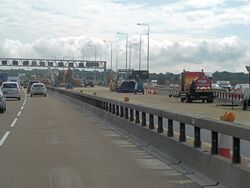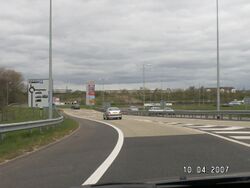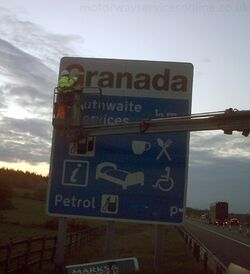National Highways

'National Highways' is the current name of the government-owned company responsible for operating, maintaining and improving most of England's motorways and trunk routes. The same name is used by a few organisations around the world, but this page only deals with the one in England. Despite the name, the role is devolved to regional assemblies in Scotland, Wales, Northern Ireland and London, who use their own branding.
In terms of motorway service areas, National Highways are responsible for regulating the service areas on its network through an MSA Policy and signage agreements, and to work with developers over issues such as access and signage. As part of their duty to ensure the safe operation of their road network, they also need to encourage motorists to use service areas when tired.
Predecessors
In 1969, the Motorway Service Area Branch (MSAB) was established to take the responsibility for identifying and regulating motorway service stations, on behalf of the Ministry of Transport (later the Department of the Environment/Department for Transport). In 1982 they merged with the Highways Lands and Services Division.
As part of various changes to the Department being made at the time, in 1994 the Highways Agency were created as an executive agency responsible for motorways and trunk routes on behalf of the Department for Transport. Service stations fell under their remit, under the Network General and Maintenance Division.
Shortly before the creation of the Highways Agency, the government announced that they would no longer be proposing new services. This followed a number of occasions where the Department and a private developer had gone head-to-head with two rival plans, which was seen as a waste of resources, so instead the private sector would be entirely responsible. The Highways Agency later started highlighting areas where new facilities were needed.
In their 2010 study into service stations, the Highways Agency admitted they maintained no list of the MSAs or TRSAs they regulated, and instead had to go about this study using a combination of this website, Google Earth, and by driving the length of their road network!
The Highways Agency were converted to a company in 2015, at which point they became Highways England. Highways England changed their name again, this time to National Highways, in 2021.
Freeholds

In 1982 the government re-negotiated the contract under which all of England's service areas operated. From now on the operator would purchase a 50 year lease, generally awarded to the highest bidder, and pay the landowner (the Department of Transport) a peppercorn rent.
These freeholds were passed to the Highways Agency. As part of the complete privatisation of the industry, they were instructed to sell all of them, in a process known as disposals. Some operators had been hoping to be handed the land as compensation for the contract change, but instead the land was sold to the highest bidder to encourage the operators to bid high.
By 1996, 29 of these had been sold. Political issues caused the process to be postponed indefinitely, and as a result National Highways still owns the freehold to the remaining 21 services:
- Birch (M62)
- Birchanger Green (M11)
- Cherwell Valley (M40)
- Clacket Lane (M25)
- Corley (M6)
- Keele (M6)
- Knutsford (M6)
- Leicester Forest East (M1)
- Membury (M4)
- Newport Pagnell (M1)
- Northampton (M1)
- Norton Canes (M6 Toll)
- Sandbach (M6)
- South Mimms (M25)
- Strensham (M5)
- Thurrock (M25)
- Toddington (M1)
- Trowell (M1)
- Warwick (M40)
- Watford Gap (M1)
- Woodall (M1)
This information was verified in January 2018. Since then some sources have disputed it. It is possible that some land has been sold or other agreements have been reached.
Note that the inclusion of a service area on this list does not mean that National Highways own the whole site. Since 1992, service areas such as Northampton have expanded into land they purchased privately. The hotel at Newport Pagnell, despite being one of the oldest service station hotels, was not built on highway land.
In addition to the service areas listed above, National Highways also inherited land which had been reserved for future motorway service areas but never built. Tracking the current status of these is difficult. In 2015, National Highways were reported to own:
- Moreton Valence (M5)
- Kingston Seymour (M5)
Other sources report that National Highways owns:
- Chigwell (M11; whole site, even parts which aren't used)
- Doxey (M6; majority of the site is owned)
- Lutterworth (M1; whole site, mostly used)
- Newton-le-Willows (M6; the entire southbound side, even the land which isn't used)
- Sprotbrough (A1(M); whole site, mostly used)
- Trumps Green (M3; north-eastbound side only)
Rest Areas
National Highways are responsible for providing safe lay-bys along the A-road network, some of which have an agreement with a trader to allow them to conduct business there.
Over the years there have been a number of experiments with larger lay-bys with dedicated toilet facilities, although they are usually seen as a maintenance nuisance. There are three parking areas which provide additional facilities that National Highways are also responsible for:
- Cartgate (A303)
- Sedbury Lay-by (A66)
- Great Dunmow (A120)
Note that at all three of those sites, it's reported that a tiny section of land has been sold to a private caterer.
Work With Operators

As part of their responsibilities the Highways Agency created and manage the MSA Policy for England on behalf of the Department for Transport, and as such they have, in the past, highlighted roads that could benefit from new service area construction. National Highways have to be consulted on all major changes at services in England.
Officially, National Highways are responsible for regulating the behaviour and layout of motorway service areas on their network. However, the 2013 version of the policy is very light on rules or policies. The government attitude at the time was effectively that all commercial development is good, and as a result National Highways have written themselves into a position where they are only really able to speak out if they believe a proposal is actively dangerous (as opposed to it merely being badly thought out).
Although National Highways are very strict about who is allowed to work on their motorways, approved contractors can make changes to road signs on behalf of an operator provided National Highways are informed. This allowed operators to frequently change their headerboards without inconveniencing the HE.
Whenever there is a problem with fuel or the amenity building at an English MSA, they should inform National Highways so the pre-programmed motorway warning signs can be activated.
Past Projects
The Highways Agency had previously worked with the operators to provide interactive traffic information. Briefly, they published a guide to truckstop cafés in England, which included details of a small number of motorway services.
In April 2020, Highways England launched a new spreadsheet which promised to provide live information on motorway service area facilities. Despite receiving widespread praise in the media for doing this, the spreadsheet was only updated once every 24 hours, and missed almost every single motorway service area closure that happened, including scheduled closures that their colleagues had posted about on Highways England's social media pages. The service was quietly removed after a few months, and Highways England instead referred people to this website for updates.